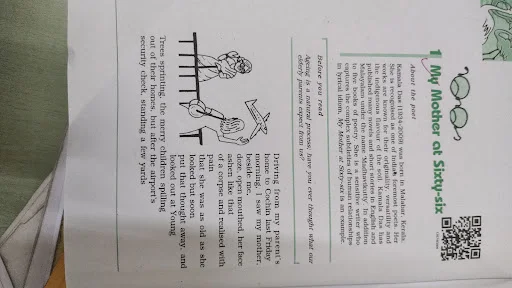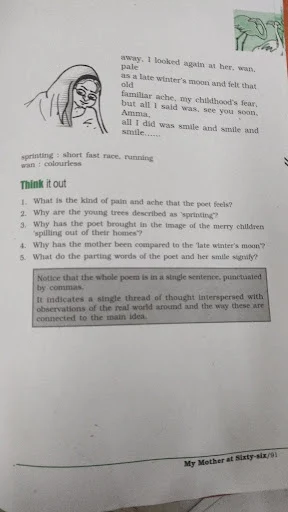**IMPORTANT QUESTIONS **
Analyze the poetic devices used by Kamala Das in "My Mother at 66" and their impact on the overall theme.
ANSWER Kamala Das employs poignant poetic devices in "My Mother at 66" to convey the theme of aging and filial love. Her rich imagery, particularly in describing her mother's greying hair and fragile frame, serves as a powerful metaphor for the passage of time. The enjambment and fluidity of the verses mimic the inevitability of aging, reinforcing the poem's emotional weight. The use of sensory details intensifies the reader's connection with the poet's complex emotions, while the symbolic car journey becomes a metaphor for life's transient nature. Das masterfully combines these devices to evoke a deep sense of empathy and contemplation on the universal theme of mortality.
Explore the symbolism present in the poem and its significance in conveying the poet's emotions.
In "My Mother at 66," Kamala Das employs poignant symbolism to convey profound emotions. The car journey symbolizes life's transient nature, with its inevitable progression and uncertain destination. The "hot, white room" represents the harsh reality of aging, emphasizing vulnerability. The "Oxygen" mask becomes a poignant symbol of life support and the inevitable reliance on external aids. The mother's "ashen, silvery hair" symbolizes the passage of time and the inevitability of aging. These symbols collectively amplify the poet's emotional depth, creating a resonant exploration of the intricate relationship between life, aging, and the poignant realization of a parent's mortality.
Discuss the central theme of aging and filial love as portrayed in the poem.
The central theme of "My Mother at 66" revolves around aging and filial love. Kamala Das vividly portrays the physical and emotional challenges of her mother's advancing age. The depiction of her "ashen, silvery hair" and the fragility conveyed through "a weary, aged softness" captures the inevitable march of time. Filial love is evident in the daughter's contemplation of her mother's vulnerability during a car journey, reflecting on the cyclical nature of life. The poem becomes a poignant exploration of the emotional complexities that arise as one witnesses a beloved parent aging, blending nostalgia, compassion, and a profound sense of mortality.
How does the poet use imagery to depict the journey and the emotions associated with her mother's aging?
In "My Mother at 66," Kamala Das employs vivid imagery to depict the journey and the emotions tied to her mother's aging. The "hot, white room" symbolizes the harsh reality of aging, while the "Oxygen" mask becomes a visual representation of life's fragility. The car journey becomes a metaphorical exploration, mirroring life's transient nature. The "ashen, silvery hair" evokes the passage of time, emphasizing the inevitability of aging. This rich imagery not only paints a poignant picture of physical decline but also intricately weaves emotions of love, concern, and contemplation, creating a profound and relatable portrayal of the complexities of witnessing a parent's aging.
Explain the significance of the title "My Mother at 66" and its connection to the poem's meaning.
Explain the significance of the title "My Mother at 66" and its connection to the poem's meaning.
The title "My Mother at 66" holds profound significance in Kamala Das's poem, encapsulating the central theme of aging and filial concern. The specific age, "66," signals a critical juncture in a person's life, emphasizing the vulnerability of the mother. It becomes a symbolic marker for the poet's contemplation on mortality and the inevitable passage of time. The title sets the stage for a poignant exploration of the mother-daughter relationship, inviting readers to reflect on the complexities of witnessing a beloved parent age. Through this numerical reference, the poem subtly suggests a universal reflection on the shared human experience of grappling with aging parents.
Elaborate on the poet's feelings and internal conflict as expressed in the poem.
Elaborate on the poet's feelings and internal conflict as expressed in the poem.
In "My Mother at 66," Kamala Das portrays a complex range of emotions and internal conflicts. The poet grapples with a mix of love, concern, and contemplation as she observes her mother's aging. There's a poignant awareness of mortality, evident in the fragile imagery and the symbolic "Oxygen" mask. The poet's conflicted feelings arise from the disparity between the external world's beauty and her internal turmoil over her mother's vulnerability. The car journey becomes a metaphor for life's transience, intensifying the emotional struggle. Das delicately navigates the tension between the external world's allure and the internal emotional landscape, revealing a nuanced portrayal of filial love and the inevitability of loss.
Compare and contrast the external world described in the poem with the internal world of the poet's emotions.
Compare and contrast the external world described in the poem with the internal world of the poet's emotions.
In "My Mother at 66," Kamala Das skillfully contrasts the external world with the poet's internal emotional landscape. The external world is vividly depicted through the scenic car journey, symbolizing life's transient nature. The "beautiful trees" and "green fields" mirror the world's outward beauty. In contrast, the poet's internal world is marked by a poignant struggle, reflecting on her mother's aging and mortality. The "hot, white room" and the "Oxygen" mask symbolize the internal reality of frailty and vulnerability. This duality creates a powerful contrast between the external allure of the world and the internal turmoil of emotions, highlighting the complex interplay between life's external beauty and the internal emotional complexities.
How does Kamala Das employ tone and mood to convey the message of the poem?
How does Kamala Das employ tone and mood to convey the message of the poem?
Kamala Das employs a somber and contemplative tone throughout "My Mother at 66" to convey the poem's poignant message. The tone reflects a mixture of love, concern, and introspection as the poet grapples with her mother's aging. The mood oscillates between melancholy and reflective, mirroring the complex emotions associated with witnessing a loved one's vulnerability. The somber tone intensifies during descriptions of the mother's physical decline, while the contemplative mood is evident in the symbolic elements like the car journey. Overall, the tone and mood collaborate to evoke a deep sense of empathy, inviting readers to reflect on the universal themes of aging, filial love, and the transient nature of life.
Discuss the role of the car journey in the poem and its symbolic implications.
Discuss the role of the car journey in the poem and its symbolic implications.
The car journey in "My Mother at 66" serves as a powerful metaphor, symbolizing the journey of life and the inevitability of aging. As the poet and her mother embark on this journey, it becomes a symbolic exploration of life's transience. The motion of the car reflects the relentless passage of time, and the changing scenery mirrors the evolving stages of life. The journey becomes a poignant backdrop against which the poet contemplates her mother's aging, adding depth to the reflection on mortality. The car becomes a vessel, transporting both the characters and readers through the emotional landscape of filial love, aging, and the universal human experience.
Explore the universality of the poem's themes and how they resonate with readers.
"My Mother at 66" resonates universally due to its themes of aging, filial love, and the inevitability of mortality. Kamala Das taps into shared human experiences, making the poem relatable to readers of diverse backgrounds. The portrayal of a parent's vulnerability in old age strikes a chord with anyone who has witnessed or contemplated the aging process. The internal conflict, emotions, and reflections depicted are not culture-specific, making the poem a poignant reflection of the universal human condition. As readers connect with the universal themes, the poem becomes a mirror reflecting their own experiences, fostering empathy and a shared contemplation of the complexities inherent in the cycle of life.
KEEP VISITING THE BLOG FOR UPDATE ON FOLLOWING
Poetry analysis
Literary critique
Kamala Das poetry
Aging and filial love
Emotional complexities
Life's transience
Mortality reflection
Universal themes
Symbolism in poetry
Mother-daughter relationship
Kamala Das aged mother
Layers in My Mother at 66
Poetic examination
Kamala Das symbolic poetry
Emotional intricacies in poems
Profound poetry analysis
Aging in literature
Nostalgic poetry reflection
Introspective literary critique
Poetry's internal conflicts
Modern poetry analysis
Literary trends 2024
Kamala Das influence
Emotional resonance in literature
Aging in contemporary poetry
Symbolism trend in poems
Critical appreciation blogs
Thought-provoking poetry
Current literary analysis
Evocative poetry trends
Maternal aging in poetry
Daughter's contemplation
Life's transient nature interpretation
Poetic reflections on mortality
Universal human experiences in literature
Emotional nuances in Kamala Das poems
Symbolic elements in literary works
In-depth literary critique
Parental vulnerability themes
Thoughtful exploration of poetic layers
FREQUENTLY ASKED QUESTIONS AND ANSWERS
Q: What is the central theme of Kamala Das's poem "My Mother at 66"?
A: The central theme revolves around aging and filial love, portraying the poet's contemplation of her mother's vulnerability and the inevitable passage of time.
Q: How does Kamala Das use symbolism in the poem?
A: Das employs symbolism, such as the car journey representing life's transient nature and the "Oxygen" mask symbolizing life support, to add depth and layers to the poem's meaning.
Q: What role does the car journey play in the poem?
A: The car journey serves as a powerful metaphor, symbolizing the journey of life and emphasizing the relentless progression of time.
Q: How does the poet use imagery to depict emotions in the poem?
A: Vivid imagery, like the "hot, white room" and "ashen, silvery hair," paints a poignant picture of the mother's aging, intensifying the emotional depth of the poem.
Q: What is the significance of the title "My Mother at 66"?
A: The title signifies a critical juncture in the mother's life, emphasizing vulnerability and setting the stage for a profound exploration of aging and filial love.
Q: How does the poet's tone contribute to the poem's emotional impact?
A: The somber and contemplative tone intensifies the emotional depth, reflecting a mix of love, concern, and introspection as the poet grapples with her mother's aging.
Q: Why does the analysis consider the poem's universality?
A: The analysis explores how themes of aging, filial love, and mortality make the poem relatable to a broad audience, tapping into shared human experiences.
Q: What are some symbolic elements discussed in the analysis?
A: The "Oxygen" mask, "ashen, silvery hair," and the car journey are symbolic elements discussed, adding layers to the poem's meaning and conveying deeper emotions.
Q: How does Kamala Das make the poem universally resonant?
A: By tapping into shared human experiences and emotions, such as aging and the parent-child relationship, Kamala Das makes the poem relatable and universally resonant.








No comments:
Post a Comment
thank you